1 Introduction
While structure building based on Merge is the core business of syntax (Chomsky 1957; 1988; 1995; Hauser et al. 2002; Fitch et al. 2005; Chomsky 2009), the status of structure undoing or structure removal is less clear. Only two works systematically focused on operations performing the “opposite” of Merge: Remove (Müller 2017b) and Exfoliation (Pesetsky 2021). In this paper, I follow these works and explore the possibility that syntax both builds and undoes structure. The proposal developed here, however, is based on a different operation: Bud.1 The key difference between this approach and the others is that structure undoing is not achieved by an operation that does the opposite of Merge, like Remove, or by partial deletion of some feature/projection like Exfoliation. With Bud, structure reduction is achieved by applying the same procedure as External Merge to a non-root projection. Bud can be seen in part as a simplification of Exfoliation, while it is offered as an alternative to Remove, although it incorporates some insights of these two operations.
Incorporating Bud into syntax will allow to derive in a simple manner syntactic alternations like active-passive sentences (1) and finite-infinitival sentential complements (2). The main theoretical advantage of using Bud is that this is done without any looking ahead, hence active sentences like (1a) or fully finite complements as (2a) are first generated and then transformed into a passive sentence like (1b) or in an infinitival complement like (2b).
- (1)
- a.
- John kicked the ball
- b.
- The ball was kicked (by John)
- (2)
- a.
- Mary believed that John was guilty
- b.
- Mary believed John to be guilty
An overview of what Bud does when it applies to a derivation is sketched in (3). The step in (3b) looks similar to the outcome of Graft (van Riemsdijk 2000 and subsequent works) and Parallel Merge (Citko 2005 and subsequent works) in that it creates a multidominated structure.
- (3)
- Bud: an overview
- a.
- δ selects β
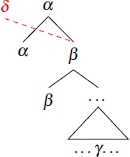
- b.
- Multidominance
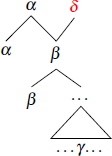
- c.
- After Bud
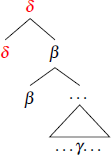
The shared property between Graft à la van Riemsdijk and Parallel Merge à la Citko is that the resulting structure contains a node that is multi-dominated. The result of Bud as proposed here, however, is not a multidominated structure, hence it is intrinsically different both from Graft and Parallel Merge. In fact, Bud can be visualized as a multi-step procedure: The first step involves a selection operation, as in (3a). Like with External Merge, a head selects the syntactic object it will merge with. The second step involves the standard set merge operation between a selecting head and a syntactic object, as in (3b). The main difference between classic External Merge and Bud, then is that the former always applies to the root of a syntactic object, while the latter applies to a non-root node. It is at this intermediate step that an apparent multidominated structure is created. In the last step (3c), Bud leaves out of the derivation one portion of the previously built object, removing one of the two heads responsible of multidomination, namely α. In the subsequent steps of the derivation, δ is allowed to grow but not α. In passive sentences like (1b), the auxiliary be buds an active/transitive vP removing the external argument, yielding a passive syntax. This operation is a key factor in deriving passive sentences from transitive ones without postulating voice ambiguity on the lexical verb, or weak phases and, most importantly, without looking ahead.
If an operation like Bud is part of the syntactic component of human language, three crucial questions immediately arise: the first one concerns how the new operation integrates with the rest of the syntactic machinery, the second one concerns its actual application in human languages; the third one concerns its explanatory power. These questions will be addressed in turn in the rest of the paper. Section 2 provides an overview of how Bud fits in the current minimalist syntax, discussing how the operation can be constrained in such a way that overgeneration of structure undoing is avoided, how it interacts with the normal cycles of structure building, and with fundamental sentence building operations like Merge, and Movement (Agree+Merge). The discussion in this section will be highly abstract, so the reader who is mostly interested in the empirical consequences of Bud may skip this section and directly go to Sections 3 and 4 which illustrate some empirical applications of Bud. Section 3 illustrates how Bud operates at the level of the vP phase, generating analytic passive constructions and (Italian) causatives. Section 4 extends the proposal by looking at a case of CP/TP Bud, namely raising constructions. Section 5 concludes the paper. Two appendices are available as supplementary files. A comparison of Bud with the alternative operations Remove and Exfoliation is discussed in Appendix A. Appendix B discusses the role of Bud in “mitigating” syntactic complexity and provides a better understanding of computational efficiency in passive constructions and in other domains where there is evidence of reduced structures.
2 Bud & the syntactic machinery
Operations leading to structure removal obviously result in reduced structure. Bud is not different from Remove (Müller 2017b) and Exfoliation (Pesetsky 2021), although its deep nature is essentially the same as that of (External) Merge, namely the operation designed to create and expand structure.
The definition of Bud is provided in (4), where δ is lexically specified to select β.2 In the simplest application, the budding head selects a syntactic object from the workspace (5a), merges with it (5b) and replaces it with a new syntactic object (5c), exactly like External Merge. The budded portion then “returns” into the numeration.
- (4)
- Definition of Bud
- Bud(δ, {…,{α,{α,β}}}) ={δ, {δ, β}}
- Selectional properties: δ[ —β]
- (5)
- Step by step procedure
- a.
- Bud step 1:δ enters the workspace and selects β
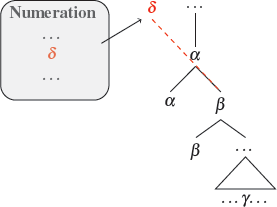
- b.
- Bud step 2: Merge to non-root generates (temporary) multidominance
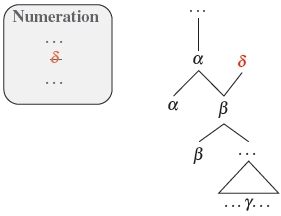
- c.
- Bud step 3: A new syntactic object is generated
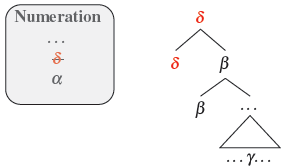
Differently from External Merge, though, the output of Bud does not contain the previous syntactic object plus the new head. In fact, it only contains a portion of the previous syntactic object plus the new head. The part that is cut-out of the derivation returns to the numeration as a syntactically inactive object in a sense that will be clarified below. The main difference between Merge and Bud is only the size of the syntactic constituent selected by the triggering head. It is always the root of a syntactic object with Merge, it is a lower projection with Bud.3
Since Bud is a variant of Merge, it may have a considerable impact on the fundamental architecture of syntax and it is expected to behave like Merge with respect to conditions and constraints governing its application. There are issues of how Bud relates with the architecture of human language in terms of overgeneration (Section 2.1), cyclicity (Section 2.2), phases (Section 2.3), movement (Section 2.4) and the numeration (Section 2.5). I will address each of them in turn.
2.1 Bud & Overgeneration
I start by discussing how the search domain is constrained by Minimality, and how the No-Tampering Condition needs to be revised in order to accommodate structure removal. In doing this, I also exemplify what happens when Bud applies to more complex structures. Finally, I address some lexical aspects concerning the nature of the features triggering Bud.
If Bud were completely unconstrained, nothing would prevent its application to remove more structure than needed. For instance, if the selection properties of a head are compatible with two or more sub-parts of a tree, then Bud may in principle apply at different heights. This is illustrated in (6), where the selection properties of the head δ are compatible with both β and ɛ. In this scenario, δ could in principle select either subtree of the syntactic object headed by α.
- (6)
- General schema of application
- a.
- Canonical application
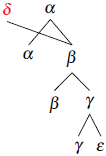
- b.
- Unconstrained application
- (β and ɛ of the same type)
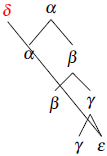
Something very general should prevent this unconstrained and undesired application of Bud. One possibility is to appeal to Minimality (Rizzi 1990) to prevent this type of over-generation. Under this view, if β and ɛ are of the same type as in (6b), ɛ is not accessible to δ because there is a closer accessible element in the search domain of δ, namely β. This option allows Bud to operate independently from phases, although being constrained by locality conditions (but see Section 2.3). In other words, Bud obeys the same principles of another type of merge, Internal Merge (aka movement). An example of this type is briefly discussed in (8b) below, other cases in which the effects of minimality are visible are discussed in Section 2.4.
In a scenario where the search is not blocked, a budding head is free to probe lower phrases and, in principle, even specifiers. The former case is illustrated in (7), the latter in (8).
The selectional properties of δ are satisfied by some feature of ɣ in (7a). Once Bud applies, β is removed from the projecting structure. As correctly pointed out by a Glossa reviewer, the definition of Bud remains neutral about what happens to α and its specifiers. The question is whether they remain exactly where they are, as in (7b), or whether they are removed as well, as in (7c). Crucially, the new constituent made by δ and ɣ is still somehow separated from α. This is emphasized by the lack of projecting label in (7b). In order for the new constituent to be part of α, a new Merge operation must occur after δ has projected. However, the probing features of α have already been used to select β in the steps before (7a) and therefore are syntactically inactive. The immediate consequence is that, after Bud in (7a), the derivation cannot continue as in (7b), while the continuation in (7c) does not raise particular issues. This type of derivation will be used for infinitival complements in Section 4. Notice, incidentally, that structures like (7b) would be the result of countercyclic operations, something to avoid on independent grounds.
- (7)
- Budding a lower head
- a.
- δ[ —ɣ]

- b.
- δ replaces β
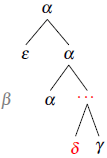
- c.
- δ removes β and the nodes above
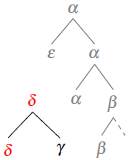
Whether the search space should include specifiers and materials inside them, as in (8a) and (8b) is quite intricate. As long as successive cyclic movement, smuggling, and peeling allow heads to probe specifiers and materials inside them, there is no principled limitation that would prevent the search space of Bud to include them as well. If overgenerations of these types are to be excluded, I assume it is done by other types of filters, possibly at the interfaces.
A derivation similar to (8a) would be one in which δ is a verb that can select either a CP or a DP, like interrogative predicates. Assuming that α and ɣ are equally visible (i.e., that the root α is as high as its specifier ɣ), δ would be free to either merge with α or to bud it, hence merging with ɣ. The resulting structures would be interpreted as an embedded question with the wh-phrase in the specifier of the embedded clause in the first case, and probably as a simple direct question after the DP has further moved higher in the structure in the second case. I can only assume that if there are numerations leading to such structures, these cases of overgenaration will be excluded by some semantic filter.
A derivation similar to (8b) would be one in which α is a CP, ɣ a topicalized nominal expression containing a relative clause (ɛ). However, in this scenario minimality would prevent δ from selecting ɛ because there is a higher phrase of similar type, namely α.
- (8)
- Budding a specifier
- a.
- δ[ —ɣ]

- b.
- δ[ —ɛ]
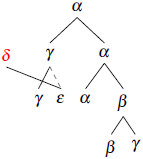
Another subtle and perhaps more insidious aspect is the interaction with the No-Tampering Condition (Chomsky 2008: 138).
- (9)
- No-Tampering Condition
- Merge of X and Y leaves the two S[yntactic] O[bject]s unchanged. If so, then Merge of X and Y can be taken to yield the set{X, Y}, the simplest possibility worth considering. Merge cannot break up X or Y, or add new features to them.
Bud does not add any new feature to the previously built syntactic object. However, it does break a previously established syntactic object. The problem is concrete as Bud leaves out of the derivation one portion of an already built syntactic object. This is shown by comparing the output of Merge and Bud in (10). The output of Merge leaves both δ and {α,{β}} unaffected, while the output of Bud replaces α with δ.
- (10)
- a.
- External Merge(δ, {α, {α, β}}) ={δ, {δ, {α,{α, β}}}}
- b.
- Bud (δ, {α,{α, β}}) ={δ,{δ, β}}
This is probably the weakest point of any theory of structure removal.4 One can think of several ways to soften the No-tempering Condition so that these cases of structural removal are tolerated. An alternative would be to redefine the No-tempering Condition so that it only contains the ban on adding features. That version of the No-tempering Condition would then be very similar to the Inclusiveness Condition (Chomsky 1995).
A second way to constrain Bud is by identifying which elements do in fact select for a reduced set to merge with. Deciding which head requires a smaller portion of the structure is an empirical issue, subject perhaps to the language specific idiosyncrasies of the lexicon. Sections 3 and 4 illustrate analytic passive, Italian causatives and raising constructions as concrete applications. Other constructions are also mentioned in the Appendices A and B. As for passive and causatives, it is the alternation between auxiliaries that governs Bud, while in the case of raising constructions the alternation between Merge and Bud resulting in finite and infinitival complements is governed by the selectional optionality of these predicates of taking a full CP or a subpart of it as a complement.
Pesetsky (2021) addresses a similar issue when he tries to identify the possible size of Exfoliation. He proposes an interesting typology based on fine-grained assumptions about the specific structures involved (e.g., WP superstructures) and language internal evidence for overt complementizer alternation (e.g., que-qui in French). Although more careful research is probably needed, it seems to me that the same set of assumptions needed for Exfoliation to derive these constructions would suffice for Bud to cover exactly the same phenomena. More generally, it is part of the empirical work to identify and specify what are the triggers of Bud by looking both at potentially universal triggers (e.g., passive, raising, etc.), and at language specific triggers (e.g., restructuring predicates). While in some cases like passive, it is possible to find a deeper explanation why passive requires structure reduction (see Section 3.1), in other cases such deeper explanation is still to be found.
2.2 Bud & Cyclicity
Minimalist syntax operates within the principle of strict cycliticy (Chomsky 1995; 2000; 2001; 2008). I will show that Bud operates in an apparent countercyclical way, because the budding head does not merge to the root of the syntactic structure. However, the resulting structure will never show the effects of countercyclity because the upper part of the structure is cut out of the derivation, and a new cycle is “re-opened”.
The implementation illustrated in (5) shows that the countercyclicity of Bud is only apparent. The structure in (11a) is a clear case of countercyclicity. The head δ sneaks into the derivation between α and β. On the other hand, Bud replaces the topmost part of a structure in (11b), avoiding countercyclicity.
- (11)
- a.
- Counter-cyclic Merge
- δ sneaks in between α and β

- b.
- Bud reopens a cycle
- δ replaces α

In fact, Bud introduces a new cycle, i.e., a “new root” to the previously created object and the effects of cycle violation never surface. When Bud applies to a phase head, it reopens an already closed cycle. In this respect, it looks as if it allows for subsequent countercyclic operations. We will see in Section 3.1 that this is precisely what happens to the vP phase in the analytic passive. The possibility of “re-opening” a phase will also affect the probing domain allowing movement from positions that would be inaccessible due to the Phase Impenetrability Condition (see Section 2.3).
Bud interacts with another general requirement of structure building which is sensitive to cyclicity, namely the one that prevents a derivation from looking-ahead to the following stages of a derivation (Chomsky 2004). Looking-ahead raises every time a reduced structure is required at later stages of a derivation and the most compelling case is when the requirement becomes apparent across phases. This is one of the challenges that Bud faces together with Exfoliation and Remove, a fact to which I will return in Section 3.1 and in Appendix A for concrete examples.
One possibility of satisfying the requirement is to deal with it at the moment of defining the numeration or the workspace (i.e., a derivation cycle) as is suggested in Chomsky (2019) and concretely done with Remove (Müller 2017b). This is achieved by assuming a highly flexible distribution of features. Specifically, the features that perform structure undoing can be present or absent in any lexical or functional item depending on the particular derivation to be performed. For instance, they are present in the vP/VP complex in passive derivations, where partial vP undoing is required, but absent in their active counterpart. This flexibility removes the issue of looking ahead from syntax by placing it at the level of the selection of the lexical entries accessible from the workspace. In this case, a precise theory of how workspace, numeration and lexical array are generated is needed to find an adequate explanation of the phenomena.
An alternative to prevent looking-ahead is to adopt top-down operations. The derivation of lower cycles are thus completely blind to the following steps. Under this approach, any new element entering a derivation may trigger structure reduction over a syntactic object that has been built, independently from its particular structure, features, and independently from the internal structure of the already built syntactic object. The challenge for this approach is to determine which features trigger the operation, which lexical or functional head can carry them and possibly why, an issue to which I will return when discussing the practical case of vP Bud. This alternative option is the one adopted both by Bud and Exfoliation. The abstract examples of Bud illustrated above already show that the operation is performed by a head producing a top-down reduction of the structure. In this respect, what happened at the earlier stages of a derivation does not affect the application of Bud. Specifically, the derivation that builds α in (12a) is created without expecting the budding head δ to enter the derivation in (12b).
However, since Bud allows to re-open closed cycles, one crucial point concerns the interaction between syntax, morphology and morpho-syntactic operations that affect the shape of morphological exponents. This is illustrated in (12), where agree between α and ɣ has checked the relevant unvalued φ-feature of α as the by-product of the probe-goal search, and the unvalued feature F on ɣ to a specific value as a free rider, as in (12a). This is the typical situation of Case marking. After Bud has applied, the new head δ probes again in the same domain and checks as a free rider the feature F in ɣ, as in (12b). Assuming that features can be checked multiple times in the course of a derivation, three options are available at the morpho-phonological level, as illustrated in (12c), ɣ retains its current exponent (+Fexponent1), it shows the newly assigned exponent (+Fexponent2), or it shows both exponents, possibly respecting some version of the Mirror Principle (Baker 1985). The optionality offered by the syntactic module, though, requires an architectural design where lexical specification/insertion is done at a post-syntactic stage, as in the case of Distributed Morphology (Halle & Marantz 1993; Embick & Noyer 2007), or Nanosyntax (Baunaz et el. 2018) and the particular outcome of the exponent is regulated by post-syntactic processes.
- (12)
- Interaction between Bud and Morphology
- a.
- α checks F on ɣ
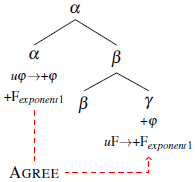
- b.
- δ buds α and checks F on ɣ
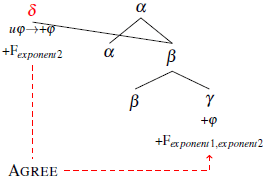
- c.
- Possible outcomes of a multiply checked feature
- • Only [+Fexponent1] in ɣ is spelled out
- • Only [+Fexponent2] in ɣ is spelled out
- • Both [+Fexponent1-exponent2] in ɣ are spelled out
One concrete example of this typology is offered by case marking. Under a multiple case checking approach (Bejar & Massam 1999) languages may vary in what gets spelled out. Specifically, English displays the first type, Hungarian, Nieuan and Norwegian the second type (Bejar & Massam 1999), while Korean displays the third type (Yoon 2004).
2.3 Bud, Select, and phases
External Merge is preceded by an operation of selection, select, where an active head identifies the syntactic object it is going to merge with. In the standard cases, select is limited to identify the topmost projection of a syntactic object (or its label) because there is a perfect match between the requirements of categorical selection of the items in the numeration and the syntactic object in the workspace. Differently from External Merge, the selecting head does not merge with the topmost projection in Bud, rather it selects a lower projection, as shown in (13).
- (13)
- Search domain of a budding head
- Selectional properties: δ[ —β]
- α and β do not share any relevant feature.
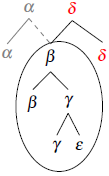
However, things are not so smooth as it may appear prima facie. Two cases can emerge: the budding head and the portion to be budded belong to two different phases, or they belong to the same phase.
If phases are modeled by a strict version of the Phase Impenetrability Condition as in (14), only the phase-head and its edge are visible across phases.5
- (14)
- Phase Impenetrability Condition (Chomsky 2001: 13)
- The domain of H is not accessible to operations outside HP; only H and its edge are accessible to such operations.
When the topmost projection is fully expanded (i.e., it projects a specifier, and possibly some adjuncts), the head, and its outer layers will be visible, but not its complement. This is shown in (15), where the accessible heads are indicated in black, and the inaccessible ones in gray. If select is limited by the Phase Impenetrability Condition, Bud would never be allowed across phases.
- (15)
- Budding head and budded head belong to separate phases
- α is a phase head.
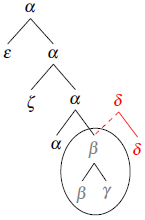
One way to obviate to this problem is to assume that labels are the only visible elements of a structure after spell-out.6 This move would leave intact minimality effects as discussed in Section 2.1. If none of the visible elements above β satisfies the category requirements of δ in (15), then δ is allowed to dig down to the complement of α and merge with β, budding all the layers above it. In the case in (15), a new cycle restarts once Bud has applied because the phase head α has been removed. As a consequence of this, β and everything in its complement is fully visible and δ can further probe ɣ, for instance, like when a passive head attracts the complement of a verb to the specifier of TP. This visibility is not far from the order preservation required by the linearization procedure in Fox & Pesetsky (2005: 6), where phase internal word order is retained and accessible for inspection across phases. However, allowing select to search for a label within the complement of a closed phase is not as an innocent move as it seems, as noted by a Glossa reviewer. It requires that a spelled-out syntactic object or at least some traces of it (i.e., the labels in our case) remain somehow available in the workspace. Notice that a similar assumption must also hold in the Exfoliation approach (Pesetsky 2021: 12, example (20)), where a modification of phase impenetrability is proposed such that probing inside the complement of a phase is always allowed, while extraction is conditioned on the goal being at the edge of the exfoliated phase (See Appendix A for a more detailed comparison).
The second scenario involves a numeration where two heads, say α and δ, can select for the same syntactic object within the same phase, as in (16). Two possible outcomes are expected. Either α merges first and then δ buds α as in (16a), or vice-versa as in (16b).
- (16)
- Two heads in the same Phase
- a.
- δ buds α
- α[ —β]
- δ[ —β]

- b.
- α buds δ
- α[ —β]
- δ[ —β]

If two heads with identical selectional properties are present in the same phase, the one that merges first gets budded and its presence will never surface in the overt syntax. If such numerations are attested, they may allow for genuine free alternation. As far as I can see, such alternation is not expected to cause a derivation crash.7 We will shortly see that something similar, although not identical, happens in the derivation of analytic passive.
2.4 Bud & Movement
This section illustrates the interaction between Bud and movement. One of these interactions is observed when Bud removes a phrase that is a source of minimality. In the example in (17), the intervening DP2 at the phase edge α is removed from the structure allowing δ to probe the most embedded DP1. This is a simplified illustration of how passive is derived under Bud in Section 3.1.
- (17)
- a.
- δ buds α and removes DP2
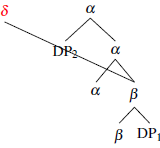
- b.
- EPP attracts DP1 to Spec,δ
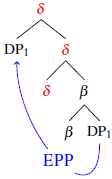
Another case is when the budded portion contains a moved phrase. The lower copy can be probed and further generate higher copies, as in (18). This is how raising constructions are derived in Section 4, where α = CP and β = TPfinite.
- (18)
- a.
- DP2 has moved to β
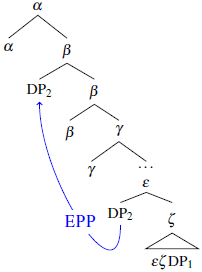
- b.
- δ buds down to β

- c.
- Lower DP2 moves to spec,δ
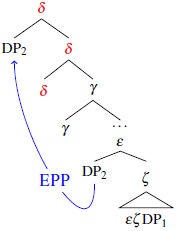
Another possible interaction between Bud and movement is found when Bud removes a barrier for movement, as in (19). β is blocking the movement of a DP to the specifier of α in (19a). After δ enters the derivation, β and α are removed due to Bud in (19b). Unless other barriers intervene, the DP can be probed by higher projections as in (19c). Although I will not discuss this possibility here, one can easily think to the availability of wh-extraction in infinitival vs. finite complements as modulated by Bud along these lines. Specifically, the budding head would remove a doubly filled complementizer in (19b).
- (19)
- a.
- β blocks movement
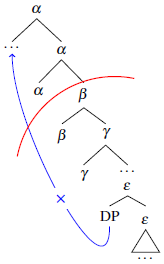
- b.
- δ buds down to β
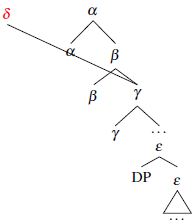
- c.
- ζ attracts DP
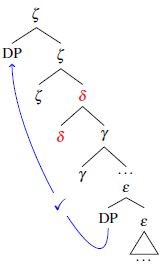
One final point concerns the typology of External Merge, Internal Merge and Bud. While Bud is the equivalent of External Merge applied to a non-root structure, movement seems to always target a root specifier. Notice that the question is not whether movement can or cannot target lower specifiers of the top-most projection. In fully derivational approaches to syntax, countercyclic movements of this sort are very rare to find but attested. One example described in the literature is multiple wh-fronting where an object wh-phrase tucks-in below the subject wh-phrase to avoid subjacency (Richards 1999). Another potential case is right-node raising constructions. The question is rather whether movement can trigger structure reduction in a similar way as Bud does. A potential case is illustrated in (20), where the topmost head α probes ɛ, as in (20a). Since α is endowed with an epp feature, it also triggers re-merge of ɛ. However, rather than targeting the specifier of α, ɛ targets the lower specifier of β, as in (20b). Finally, the structure above β gets removed, as in (20c).
- (20)
- Bud after movement
- a.
- α probes ɛ
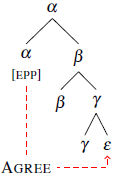
- b.
- ɛ merges with β
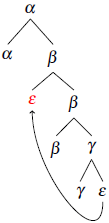
- c.
- α is removed
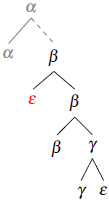
The definition of Bud in (4) does not allow for such derivations. However, the question is whether these cases are empirically attested in human language at all. If that is the case, the issue is whether Bud should account for them or other factors/operations should be invoked for an explanation. In the former scenario, Bud is clearly under-generating, while in the latter scenario either Bud would be orthogonal or it would be a contributing factor but not the only one. Let me finally notice that a derivation that includes the steps in (20a) and (20b), but not step (20c) has been proposed in the literature to account for subject movement to spec,TP. In that specific framework, some features of C percolate down to T so that the external argument is attracted in spec,TP, rather than to spec,CP (Chomsky 2007).
2.5 Budded materials
One last point to address concerns the situation of budded materials. The preview offered in (5) indicated that the budded material returns to the numeration. In this section, we will see the consequences of this and whether the status of budded material may induce a crash in the derivation. We will also see how items that undergo Bud can be selected and reintroduced into the derivation.
Clearly, the budded portion of a derivation must be invisible to the interfaces otherwise there would be phonological externalizations or semantic effects as in multidominated structures. More generally, the budding head determines which portion of a derivation is visible, but does not specify what happens to the budded material. Potentially, the range of Bud might include at least one head and at the most several heads, and their specifiers and adjuncts, as shown in (21). If δ is specified to select for β, it will only bud the topmost layer α. If δ is specified to select for ζ, it will bud all layers above ζ, including two heads (α and β) and two specifiers (ɣ and ɛ).
- (21)
- The range of Bud selection
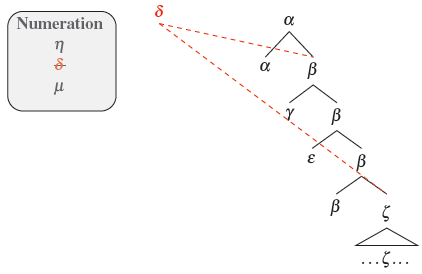
The question is what happens to the budded part after the operation is completed. There are at least two possibilities. One possibility is that the non-projecting part stays attached to the syntactic object but is invisible to probing heads, so that it will not generate minimality and will not enter into competition for agree. The derivation would continue by merging and spelling out only the structure that is selected by the projecting heads, leaving the budded part to dry-out, as shown in (22), where the largest bud of (21) is considered.
- (22)
- The budded structure dries-out
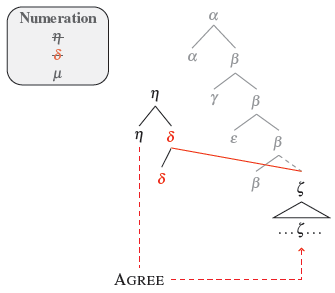
Another possibility is that once the new syntactic object is created, the non-projecting part is completely removed from the structure, similarly to what happens with Remove, where the terminal nodes return to the numeration. The derivation would then continue by merging the next head, as illustrated in (23). However, differently from Müller (2017b), where Remove literally detaches each node one at a time, allowing them to return to the numeration as bare heads, an additional assumption must be introduced here. Either the phrasal structure of the budded element is eliminated once it enters the numeration (23b), or the numeration is allowed to accommodate pieces of structure (23c).8
- (23)
- Budded nodes return to the numeration
- a.
- Structure after Bud
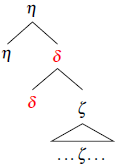
- b.
- Bare heads
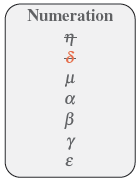
- c.
- Heads and structure
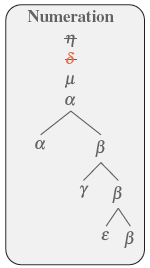
I assume that budded items return to the numeration as heads, although at the moment there is no compelling evidence to exclude the alternative option.9
Another difference between a standard derivation and a budded derivation concerns the shape of the numeration throughout a phase. The numeration or lexical array is completely empty at the end of each cycle in standard derivations. This is different if a derivation involves Bud. The numeration does not have to be empty for a derivation to be correctly completed.10 In a phase-based syntax, a pre-requisite to start a derivation is that the relevant lexical material is selected and made available in the workspace (Chomsky 2001; 2007; 2008). Associated to this part of the architecture comes the assumption that the numeration must be empty for the next phase to start or for the derivation to be completed. Furthermore, if there are unused items in the workspace, they may well contain unvalued uninterpretable features, causing the derivation to crash (Chomsky 2001). However, when structure reduction applies, syntactic and lexical materials are removed from the main structure, thus an account must be offered for these elements that are not anymore part of a sentence. A crucial point concerns the status of the budded material, whether it is syntactically active or not. Heads typically exhaust their probing activities before a new head is merged, hence becoming syntactically inert. However, things may be different for specifiers or their corresponding terminal nodes, which may still contain syntactically active features (i.e., unvalued, uninterpretable features). Unvalued, uninterpretable features must be checked/valued before the end of the phase, or they must be attracted to the phase edge, otherwise the derivation would crash. The same constraint applies to derivations undergoing Bud. If any of the terminal nodes in the budded portion of (22) that has re-entered the numeration in (23) contains an unvalued uninterpretable feature which does not get valued, the derivation will crash. If all the uninterpretable features of the budded structure have been checked before the end of the phase, the derivation may go on to the next phase, where the numeration is reset.
Interestingly, the fact that the items in the budded structure must be syntactically inert for a derivation to continue does not prevent that an active head in the phase may select them. Consider for instance (23a) and the numeration in (23b), where μ is still active, while α, β, ɣ, and ɛ re-entered the numeration after Bud, possibly with all their uninterpretable features checked. If μ is specified to select for ɣ, it is perfectly licit for the two items to merge. This new syntactic object can then be merged to the main structure either because it is selected by η or as an adjunct, as in (24).11 This is how by-phrases are generated in Section 3.1.
- (24)
- Re-merge of budded items
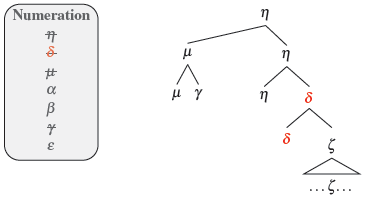
The derivation in (24) has exhausted all its active heads. The syntactic object is ready for spell-out, while the material in the numeration is syntactically inert. After spell-out, a new phase may start with a new numeration and the budded parts will be removed from the workspace. Alternatively, they are carried over phase by phase until the end of the derivation as a “residual waste”. The two possibilities lead to different predictions which I will investigate in future work.
2.6 Interim Summary
In this section, I introduced Bud in the architecture of syntax and defined it as a Merge-based operation that removes parts of an already built syntactic structure. The operation is visualized as composed of multiple steps: first a head enters a derivation selects a non-root projection, and then merges with it. The definition and its implementation given in (4) and (5) are repeated below.
- (4)
- Definition of Bud
- Bud(δ, {…, {α, {α, β}}}) ={δ, {δ, β}}
- Selectional properties: δ[ —β]
- (5)
- Step by step procedure
- a.
- Step 1:
- δ selects β
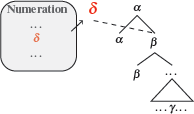
- b.
- Step 2:
- Merge to non-root
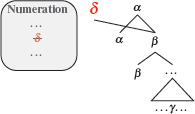
- c.
- Bud step 3:
- New syntactic object
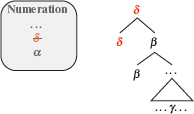
I showed how the search domain of Bud is limited by Minimality and by the Phase Impenetrability Condition. I illustrated how Bud interacts with the other basic building blocks of syntax, like select, and movement, and how it obeys the principle of cyclicity and the no-look ahead requirement. Like other operations of structure undoing proposed in the literature, it does not respect the no-tampering condition, it requires an accommodation of the Phase Impenetrability Condition for labels, and it also requires that lexical material is late inserted in the process of sentence generation. Differently from Merge, Bud may re-open a closed cycle, letting lower copies of budded items to serve as goals for higher probes. This last property is the consequence of select being able to search inside a closed phase, if needed.
Structure reduction operations like Remove and Exfoliation have been proposed as a formal tool to account for a variety of constructions, which are summarized in Table 1.
List of the constructions accounted for by structure removal/reduction.
| Construction | Reference |
| Analytic Passive | Müller (2017b) |
| Applicatives in German(double object constructions) | Müller (2017b) |
| Restructuring sentences | Müller (2017b) |
| Complex prefields | Müller (2017a; b) |
| Clause typing | Pesetsky (2021) |
| – Raising to Subject | |
| – Raising to Object | |
| – Kayne’s paradigm | |
| – Non-obligatory control | |
| – Superstructures |
Reasons of space prevent me from going through each of these constructions to show how Bud can account for each of them and how similarly or differently from Remove and Exfoliation it behaves. In the next sections, I will illustrate a concrete application of Bud by looking at some cases of vP and CP/TP budding.
3 Budding the vP
The consequences of Bud applying at the vP level are considered in this section. For the sake of clarity, I will use simplified structures in which only major projections are considered (TP, vP and VP). This will be enough to illustrate the procedure in the most general fashion. As the reader can verify, the procedure can be easily adapted to finer grained structures, where the only difference would be the size of the budded portion. The constructions discussed in this section will instantiate the budding scheme in (25):12
- (25)
- Budding the vP
- a.
- Before BUD

- b.
- Budding head
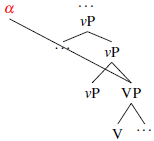
- c.
- After BUD

3.1 A derivational approach to Analytic Passive
A concrete application of Bud is in the derivation of analytic passive sentences from their active counterparts. Specifically, Bud is one of the three main ingredients that generates analytic passives. The other two are Case Theory and epp. The interaction among these three independent factors determines the emergence of the passive structure.
In a bottom-up derivation, a transitive predicate merges with its internal and external arguments within the vP phase, as in (26a). At this stage, there is no indication whether the sentence will be active or passive. Voice is determined by the nature of the following head, namely the auxiliary (or any other relevant head determining voice). If the merging head is the auxiliary be, the whole sentence will end up being passive. My proposal is that the auxiliary be selects the complement of a vP phase rather than the vP itself, hence starting the Bud process as in (26b). The final step is merging the auxiliary to the VP, leaving out the vP and its specifier, as in (26c). The derivation then proceeds as in traditional approaches to passive by moving the internal argument to the specifier of TP.
- (26)
- Derivation of Analytic Passive (version 1)
- a.
- vP Before BUD
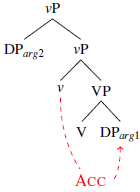
- b.
- TP selects VP
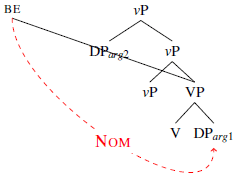
- c.
- TP After BUD
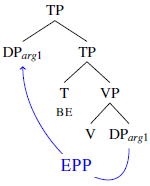
As pointed out by a Glossa reviewer, this derivation captures the object-to-subject promotion typical of passive, but leaves DParg2 without case. Following the procedure highlighted in Section 2.5, DParg2 goes back to the numeration with its case feature unchecked causing the derivation to crash. To obviate this problem, I assume that the numeration of the CP phase of passive sentences is identical to the one of active sentences with the addition of the passive auxiliary. Differently from what is tacitly assumed in derivational approaches to passive, namely that passive and active auxiliaries are in complementary distribution, I stipulate that passive derivations contain both auxiliaries, have targeting the vP and be targeting the VP. In other words, the derivation of analytic passive illustrates a situation in which two heads of the same type are part of the same phase (see the discussion in Section 2.3, example (16)). It is the computational machinery that allows the desired structure to emerge and that excludes the undesired structures, as illustrated in (27)–(29).
The derivation of analytic passive starts with a numeration that includes both the active auxiliary (have) and the passive one (be). I first discuss the case where have enters the workspace before be (examples 27–28), and then the case where be enters the workspace before have (29).
In the earlier stages of the derivation in (27), the active auxiliary has merged with the vP and has assigned nominative case to its external argument, with consequent movement of the external argument to spec,TP, as in (27a). Next, either C or be can enter the derivation. If C enters the workspace before be, two outcomes are possible both leading the derivation to crash. In the case illustrated in (27b), the newly created CP is sent to spell-out causing the derivation to crash because the numeration contains a syntactically active element, namely the passive auxiliary. In the case in (27c), be enters the workspace after the CP has been created, it selects and buds the structure at the VP level, triggering movement of the direct object to spec,TP. Since no active elements are left in the numeration, the structure is sent to the interfaces and crashes because it is incomplete (i.e., it is not headed by a CP).
- (27)
- Incorrect derivation of Analytic Passive
- a.
- Earlier stages:
- HAVE casemarks DP2
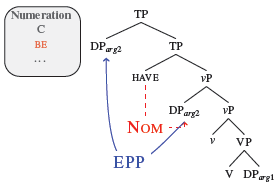
- b.
- C merges with TP⟹Crash:
- Inexhausted Numeration
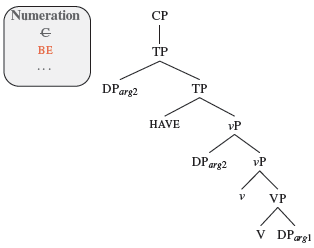
- c.
- BE buds vP⟹Crash:
- Incomplete syntactic object
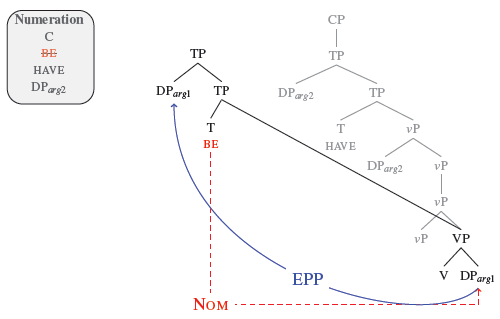
If be enters the workspace before C, a passive derivation obtains, as shown in (28). The early stages of the derivation are given in (28a = 27a). At this point, be enters the workspace and buds the structure at the VP level, as in (28b). The internal argument receives nominative case and is attracted to the passive spec,TP, as in (28c). Finally, C enters the workspace, merges with the passive TP, the numeration is exhausted and the syntactic object is sent to spell-out without problems because there is no syntactically active element left either in the syntactic object sent to spell-out or in the numeration, as in (28d). After Bud, the external argument (DParg2) returns to the numeration with its case feature checked (28c). Despite being syntactically inactive, it can be probed by an EPP feature. In this scenario, nothing would prevent the passive auxiliary be to agree with the internal argument (DParg1) and satisfy its EPP feature via external merge of DParg2. One way to rule out this undesired outcome is at the syntax-semantic interface where a clash is produced because a passive sentence surfaces with two arguments as if it were active. Concretely, one can conceive the violation as following from the Θ-criterion, since DParg2 is not linked to a Θ-position and it is not an expletive.
- (28)
- Derivation of Analytic Passive (final)
- a.
- Earlier stages:
- HAVE casemarks DP2
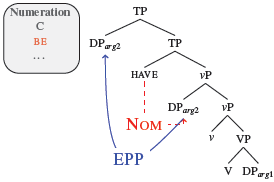
- b.
- Before Bud:
- BE selects VP
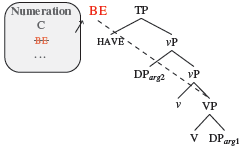
- c.
- After Bud:
- New syntactic object

- d.
- Phase Completed:
- C merges with TP
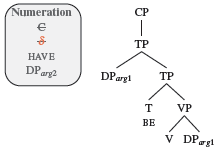
There is one more possible derivation to consider, the one in which be enters the workspace before have. Since the two auxiliaries are presumably of the same type, nothing prevents this possibility, which is illustrated in (29). In this scenario, be selects the VP and buds the vP, which then returns to the numeration with its specifier, as in (29a). Then either C or have can enter the workspace.
If C enters the workspace before have, the syntactic object is sent to spell-out, where it crashes because the numeration still contains an active element, namely the auxiliary have, and the external argument (DParg2) that has not checked its case feature, as shown in (29b).
If have enters the workspace before C, it would merge with vP and possibly attract the external argument from the numeration via EPP to which it assigns nominative case, as in (29c). However, since v is syntactically inactive because it has already exhausted its selection feature in the previous phase, it cannot bud the VP headed by the passive TP in the syntactic space. This in turn leaves two separate TPs in the workspace.13 At this point, it does not matter what C will do once in the workspace, since it would select one of the two TPs, leaving the other incomplete. Such derivations are bound to crash at spell-out.
- (29)
- Excluding undesired derivations
- a.
- Before Bud:
- BE selects VP
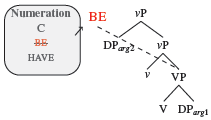
- b.
- C merges with TP⟹Crash:
- Inexhausted Numeration

- c.
- HAVE & C enter the workspace⟹Crash:
- At least one incomplete syntactic object
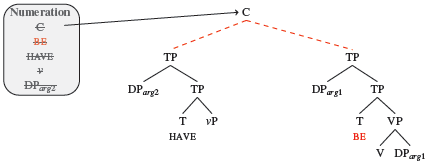
To summarize the mechanical aspects of the passive derivation in (28), the numeration contains both an active and a passive auxiliary in the CP phase. Once a transitive vP is built, the only derivation that survives is the one in which the active auxiliary is merged first and the passive auxiliary buds its VP. The material inside the VP becomes accessible, the object of the verb is probed, given nominative case and attracted to spec,TP. In this environment, it is conceivable that the passive auxiliary in T further agrees with V or some relevant head in the finer-grained structure determining the passive morphology.
A Glossa reviewer points out that passives can be derived without structure reduction if the numeration contains no vP at all or a defective vP that does not project the agent specifier (Chomsky 2000; 2001). Such derivations would be compatible with short passives only, since a separate account would be needed for by-phrases. However, even if this were the case, the resulting semantics would not conform to that of passives. In fact, the complete absence of an agent would predict a meaning virtually identical to that of middle verbs, while contrasts like * the ship sank to collect the insurance vs. the ship was sunk to collect the insurance precisely show that an understood agent/causer in the passive sentence is required. Furthermore, syntactic evidence that an agent DP is projected even in passives without by-phrases is provided later in the paper (see the discussion around examples 34–38)
There are several similarities and some differences between a Bud approach to passive on the one hand and the traditional or more recent ones on the other hand. What is shared with other accounts of passive is that nominative case is a free rider of agree between the head of T and the internal argument, and that movement to TP is epp driven. What is different from earlier accounts (i.a., Baker et al. 1989), but shared with more recent ones (Collins 2005; Müller 2017b) is that the external argument, namely the specifier of vP is always projected and it is assigned the agent θ-role. The difference with respect to Collins (2005) is that the external argument does not necessarily have to be PRO, an aspect that Bud shares with Remove (Müller 2017b). The difference with respect to Müller (2017b) is in how the external argument is left out of the main structure (see Appendix A).
Another difference between my proposal and the previous ones is what happens to the accusative case. Strictly speaking, this is not a direct consequence of Bud, but of the general approach to passive constructions as involving the same derivation as active constructions at least at the vP level. Under this perspective, the fact that an internal argument receives nominative case does not depend on the particular morphological properties of the predicate or the auxiliary but it automatically follows from strict derivational procedures. In my account, the internal argument first receives accusative case from v (or from the complex v+V) and then nominative case from T. In other words, case assignment in passive constructions is another instantiation of multiple case checking (Bejar & Massam 1999). It is resolved by letting the final Case (i.e., nominative) to be pronounced on pronouns in languages like English and Italian. Differently from Baker et al. (1989), a Bud approach to passive does not require any absorption of accusative case nor of the external argument operated by the passive morphology. The emergence of analytic passive is more a conspiracy of three factors: Bud of the vP, multiple case checking and epp on TP.
This implementation opens an interesting typology where case marking and epp are expected to interact in a significant way, as illustrated in Table 2.14 If nominative case on the passive subject is derived via multiple case checking, we would expect to find languages where passive subjects are marked with accusative case, i.e., the case assigned to the DP when it is merged as the internal argument. By the same logic, we would expect to find languages where the passive TP is not endowed by epp, hence leaving the subject of passive constructions in situ, namely in the canonical position of internal arguments. Since Case assignment and epp are independent from each other, we also expect to find languages where an accusative subject is moved to spec,TP and languages where a nominative subject is left in situ.
Typology showing the interaction between multiple case checking and epp.
| case/EPP | ✔EPP | ★EPP |
| Nom | DPArg-Nom (aux) V___ | (aux) V DPArg-Nom |
| Acc | DPArg-Acc (aux) V___ | (aux) V DPArg-Acc |
The typology is fully attested if “non-promotional passives” are considered (Givon 2001), as shown in (30) below. Within the perspective of language change, non-promotional passives are an intermediate step between impersonal constructions and canonical passives, precisely because they show some properties of full passive sentences while retaining others from the impersonal construction (Haspelmath 1990). These could involve either an internal argument marked with nominative case, or the internal argument moved to pre-verbal position or the internal argument controlling verb agreement. The fact that the distribution of these properties does not follow a specific diachronic pattern across languages is taken as evidence here that these factors are independent from each other and that each contributes to the evolution towards canonical passive from impersonal constructions.
From a synchronic perspective these clusters of properties witness the language-specific status with respects to the various factors that contribute to the creation of analytic passive. Table 3 shows that the typology is fully attested.15 Beside English and Italian, the data upon which the table is based come from Siewierska (2010) and references cited there. epp satisfaction is determined by linear order preferences, while Case is based on information about morphological case marking (with the assumption that it reflects the pattern of abstract Case marking).
Languages attesting the interaction between multiple case checking and epp.
| case/EPP | ✔EPP | ★EPP |
| Nom | English, Italian, etc. | Italian |
| Acc | Creek, Maa, Nuer, etc. | Coptic |
Languages like English fill in the top left corner, as they are [+nominative], [+epp], see the example in (30a). Maa, Nuer, Creek and Seminole all mark their patient argument with non-nominative case although word order facts cannot be taken as decisive evidence for movement to TP as the languages are either verb initial or verb final (see the example from Creek in 30b).16 Coptic, an otherwise SVO language, marks the postverbal passive subject with the non-nominative case/preposition ǝmmo which is reported as a clear marker of object encoding in (Siewierska 2010: 86), as shown in (30c). Languages that exclusively mark their passive subject with overt nominative case marking but leave it in its VP internal position are very hard to find.17 Post-verbal subjects in Italian can be taken as evidence that the typology is fully attested (see 30d), although Italian also admits preverbal nominative subjects in passive constructions.
- (30)
- Examples of the typology of EPP and Case in passive18
- a.
- I/*Me was invited to the party (by John) English
- b.
- oymó
- boiling
- łki-n yahá-n
- water-obl
- akal-ho.y-ín
- wolf-obl
- pour
- Creek
- on-imp:pl-lgr-ds
- ‘They pour boiling water on Wolf.’
- c.
- kan
- or
- eʃtʃe
- if
- ǝnt-a=u:-aikhmalɔtize
- rel-pfv=3pl-enslave
- ǝmmo-s
- prep-3fsg
- hi-tǝn-nǝ-βarbaros Coptic
- by-hand-def.pl-barbarian
- ‘or whether she had been enslaved by the barbarians (…)’.
- d.
- Sono
- be
- stato
- part
- accusato
- accuse
- io
- I
- dai
- by
- vicini. Italian
- neighbors
- ‘I have been accused by the neighbors.’
Another interaction between case marking and passive is found in Korean. Certain nominal expressions can be marked with two cases one stacked after the other. The examples in (31) from Gerdts & Youn (1999: 325) show that an experiencer subject can be marked either with dative, nominative or both.
- (31)
- a.
- Chelswu-eykey
- Chelswu-dat
- ton-i
- money-nom
- philyoha-ta.
- need-decl
- b.
- Chelswu-ka
- Chelswu-nom
- ton-i
- money-nom
- philyoha-ta.
- need-decl
- c.
- Chelswu-eykey-ka
- Chelswu-dat-nom
- ton-i
- money-nom
- philyoha-ta.
- need-decl
- ‘Chulsoo needs money.’
The possibility of displaying multiple cases makes Korean one of the best languages to test the typological prediction that the subject of a passive construction is marked both with accusative and nominative case. Unfortunately, the restrictions on case staking does not allow to completely verify the hypothesis. However, data that are very close to the ideal example have been discussed in Ryu (2013: 20). The crucial examples are reported in (32). The double accusative object in (32a) is turned into a double nominative in the passive version in (32b), as expected in normal active-to-passive derivations. Interestingly, case marking is differentiated between the two nominal elements in the subject DP of the passive in (32c). The leftmost nominal is marked with nominative, while the other is marked with accusative. As discussed in Ryu (2013), multiple case marking is only found among NPs that are in a “possessive relation”. This possessive relation is not to be intended syntactically, because unlike English possessives, sequences of NPs with the same case in Korean are never part of a single nominal constituent. In fact, in a sequence of NPs with the same case, the rightmost NP is the true argument of the predicate, while the other NPs are treated as adjuncts to the main verbal structure. What is crucial, is that the case of the adjunct NPs in a multiple case sequence depends on the case of the rightmost element. If this is correct, the example in (32c) illustrates a case in which the argument of the predicate is marked in accusative, the case assigned in the underlying syntactic position, while the dependent nominal is marked with nominative, which can only be received by the TP after the internal argument has been promoted to subject position (see Maling & Kim 1992 for a different analysis). Although not perfect, this last example is evidence that the passive subject is marked with both accusative and nominative case.19
- (32)
- a.
- Hans-ka
- Hans-nom
- John-ul
- John-acc
- tali-lul
- leg-acc
- cha-ess-ta.
- kick-past-decl
- ‘Hans kicked John’s leg.’
- b.
- John-i
- John-nom
- tali-ka
- leg-nom
- cha-ess-ta.
- kick-pass-past-decl
- ‘John’s leg was kicked.’
- c.
- John-i
- John-nom
- tali-lul
- leg-acc
- cha-ess-ta.
- kick-pass-past-decl
- ‘John’s leg was kicked.’
A Bud approach to passive can also provide a deeper explanation of why passive is the way it is. The pioneering work on the derivation of passive sentences from their active counterparts is based on the following operations/assumptions (Baker et al. 1989):
There is no external argument (it is somehow absorbed or associated to a weak vP)
The passive morphology absorbs accusative Case
The object of passive verbs move to specTP for epp reasons
nominative Case is assigned as a free rider
Most of the early work focused on whether and how these operations and assumptions were somehow linked. While assuming case absorption in fact derives the need of object movement to TP, the lack of an external argument is somewhat mysterious from the formal perspective (for a similar consideration see Müller 2017b). While agent demotion has an impact on the information structure of the sentence and on the distribution of old and new information, how it is formally possible not to have an external argument is still problematic, especially within the minimalist framework, where no-look-ahead is a general principle governing derivations. The most critical point, I believe, is the fact that when a verb is introduced in the workspace, the derivation is completely blind on whether there will be a passive syntax, i.e., whether in the next phase the auxiliary will be have or be.20 The combination of multiple case checking and epp offers an explanation of why passive ends up with the internal argument in pre-verbal position marked with nominative case. Bud, Remove and Exfoliation offer a technical explanation of how passive sentences are born with an external argument, as if the derivation were active and end up with no external argument. Differently from other accounts that postulate argument absorption, or weak vP phases to prevent the projection of the external argument, a Bud derivation of passive is done without looking ahead and without postulating a double lexical entry for transitive predicates.
In addition to that, Bud also offers a deeper explanation of why the passive construction is allowed to exist in the first place. In the implementation offered here, analytic passive is a property of the passive auxiliary which selects VPs rather than vPs. The question is why the auxiliary be selects reduced structures.21 To put it differently, why do languages need such an auxiliary? The answer is quite simple, because the lexicon contains a consistent set of predicates that do not project a full vP structure with an external argument. These are unaccusative verbs, possibly middle verbs and more generally nominal and adjectival predicates in copular constructions. The auxiliary be is the grammaticalized answer to find a suitable TP for these predicates. It is for this class of predicates that the auxiliary be is designed for. Auxiliary specialization and semantic reasons identify be as the designated auxiliary for predicates that do not project vPs (Haspelmath 1990). Italian represents perhaps the best language to illustrate the point as the auxiliary be selects unaccusative, middle verbs and copular constructions, as shown by the past infinitive forms in Table 4. The auxiliary have systematically selects unergative, transitive verbs and possessive constructions (Table 5).22
be auxiliary selection in Italian.
| Aux Selection | be | |||
| Unaccusative | Middle | Copular | Passive | |
| Past infinitive | Essere arrivato ‘Be arrived’ | Essere affondato ‘Be sunk’ | Essere elegante ‘Be elegant’ | Essere mangiato ‘Be eaten’ |
have auxiliary selection in Italian.
| Aux Selection | have | ||
| Unergative | Transitive | Possessive | |
| Past infinitive | Aver telefonato ‘Have called’ | Aver mangiato ‘Have eaten’ | Avere un libro ‘Have a book’ |
Bud in passive sentences ultimately exists because of the properties of the auxiliary be, whose original task is to combine with structures that do not project an external argument. Of course, the question is why the clear pattern of Italian is not observed in other languages. I am not in the position of providing a concrete answer to this question. There are too many factors that might have conditioned or prevented the stabilization of an Italian-like paradigm in other languages. Interestingly enough, evidence from Old English and Germanic indicate that be was used as the auxiliary for unaccusative predicates (McFadden & Alexiadou 2006), suggesting a historical transition in which Old English was more similar to Italian. In Romance languages, grammaticalization of be systematized its use as an auxiliary for all verbs with an internal argument replacing the Latin morphological passive and generating analytic passive (Danckaert 2017).
A Glossa reviewer noticed that a possible extension of this view can be found in the German impersonal passive. Simplifying a lot, an active sentence containing an intransitive unergative predicate with an animate subject can undergo passivization. The examples in (33) from Kaufmann (1995: 404) show that the unergative predicate tanzen ‘to-dance’ can be passivized and its external argument expressed with a by-phrase.
- (33)
- a.
- Auf
- at
- der
- the
- Party
- party
- tanzten
- danced
- viele
- many
- Gäste.
- guests
- ‘At the party many guests danced.’
- b.
- Auf
- at
- der
- the
- Party
- party
- wurde
- pass.aux
- (von
- (by
- vielen
- many
- Gästen)
- guests)
- getanzt.
- danced
Bud provides the underlying mechanism to derive the syntax of impersonal passive.23 If the relevant auxiliary is part of the numeration, it triggers structure reduction of the ergative vP removing the external argument. If the agentive preposition von ‘by’ is also part of the numeration, the external argument re-enters the derivation like in normal passive constructions. The impersonal interpretation that arises when an overt by-phrase is omitted might depend on the fact that the understood agent is an indefinite pronoun. Of course, the general availability of Bud in these cases depends on the presence of the appropriate auxiliary in the numeration, an aspect that must be somehow constrained in languages where the passive auxiliary does not bud unergative predicates.
Turing back to the formal properties of passive, Müller (2017b: 9, examples in 8) notices that if passive sentences start as fully-fledged vPs, then there should be syntactic evidence for that projection. Specifically, a later removed DP in spec, vP should be able to control materials inside VP adjuncts. The relevant example is reported in (34).
- (34)
- Der
- the
- Reifen
- tire
- wurde
- was
- DPext1
- aufgepumpt
- inflated
- [CP
- um
- in order
- PRO1
- die
- the
- Fahrt
- journey
- fortzusetzen].
- to continue
- ‘The tire was inflated in order to continue the journey.’
The vP structure before Remove/Bud applies is given in (35)= (8a) in Müller’s paper. The examples in (36a) and (36b) show the following steps in the derivation according to Remove and Bud, respectively. In both approaches the vP phrase is not part of the structure anymore.
- (35)
- External argument in passive construction before Remove/Bud
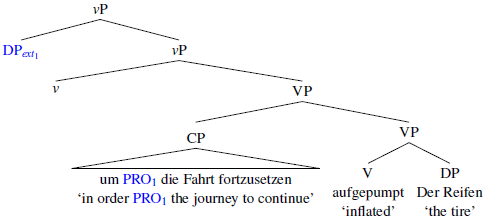
- (36)
- a.
- Passive construction after Remove
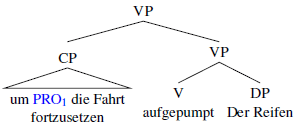
- b.
- Passive construction after Bud
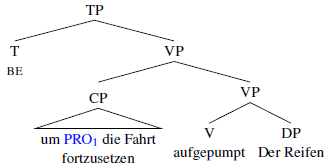
Similar examples can be reproduced in Italian as well, although the presence of an anaphoric pronoun (proprio, ‘own’) inside the adjunct clause induces degraded judgments.
- (37)
- Scenario:24 Gianni è in giro in bicicletta quando si accorge che la sua gomma è a terra. Dopo pochi minuti, …
- a.
- La
- The
- camera d’aria
- tube
- fu
- be
- cambiata
- changed
- per
- to
- proseguire
- continue
- il
- the
- viaggio
- journey
- ‘The tube was changed in order to continue the journey.’
- b.
- ??La
- The
- camera d’aria
- tube
- fu
- be
- cambiata
- changed
- per
- to
- proseguire
- continue
- il
- the
- proprio
- his own
- viaggio
- journey
- ‘The tube was changed in order to continue his own journey.’
Another interesting fact also pointed out in Müller (2017b) is that after Remove/Bud, the external argument is not accessible anymore from higher portions of the structure. In particular, the example in (38a)(=9a in Müller 2017b: 9) shows that a quantified subject in the matrix clause cannot bind the removed/budded subject of a passive sentential complement. Data from Italian do not seem to go exactly in the same direction especially when the anaphoric pronoun proprio is present. With an adequate scenario, the bound reading becomes marginally accessible when the matrix subject contains a negative quantifier, as in (38b) and fully accessible when the quantifier is not negative, like each in (38c).25 The meaning of the sentences strongly favors a reading in which students and assignments are paired. This reading is easily accessible when the overt anaphoric pronoun proprio is present in the complement DP. I assume that proprio enters in a binding chain with DPext and the quantified subject, as in (38c). When the pronoun is absent, as in (38d), the more prominent reading is the one in which there is one assignment that all students find poorly done. The reading in which each student acknowledges that their assignment was poorly done is only marginally accessible. I assume that this second reading is derived via a null possessive pronoun similar to proprio/suo. This is confirmed by (38e) where the presence of an overt by-phrase blocks the student/assignment reading.26
- (38)
- a.
- *Kein
- no
- Student1
- student
- gibt zu
- admits
- [CP
- dass
- that
- DPext1
- schlecht
- badly
- gearbeitet
- worked
- wurde ].
- was
- ‘No student admits that he did not work well.’
- b.
- ??Nessuno
- No
- studente1
- student1
- ammise
- admitted
- [CP
- che
- that
- il
- the
- (proprio1)
- (own1)
- compito
- assignment
- fu
- was
- DPext1
- svolto
- done
- male].
- poorly
- ‘No student admitted that the/their assignment was poorly done.’
- c.
- Ogni
- Each
- studente1
- student1
- ammise
- admitted
- [CP
- che
- that
- il
- the
- proprio1/suo1
- own1/their1
- compito
- assignment
- fu
- was
- DPext1
- svolto
- done
- male
- poorly
- ].
- ‘Each student admitted that the/their assignment was poorly done.’
- d.
- Ogni student
- Each student
- ammise
- admitted
- [CP
- che
- that
- il
- the
- compito
- assignment
- fu
- was
- DPext
- svolto
- done
- male
- poorly
- ].
- ‘Each student admitted that the assignment was poorly done.’
- ‘Each student admitted that their assignment was poorly done.’ (reading marginally acceptable)
- e.
- Ogni studente1
- Each student1
- ammise
- admitted
- [CP
- che
- that
- il
- the
- proprio*1/2/suo*1/2
- own*1/?2/their*1/2
- compito
- assignment
- fu
- was
- Gianniext2
- Gianniext2
- svolto
- done
- male
- poorly
- da
- by
- Gianni2].
- Gianni*1/2
- ‘Each student admitted that *their/his assignment was poorly done by Gianni.’
I now turn to by-phrases to illustrate what happens to the part of structure and to the lexical items that get cut out of a derivation. One property of by-phrases is that they do not have a particularly rigid order, a problem for analyses that insert it as part of the backbone structure of a sentence as in Collins (2005), as already noted among others in Gehrke & Grillo (2009) and in Manzini (2017). To capture this flexibility, more structure than the one used to illustrate the previous constructions is probably needed. However, how this is technically possible can be illustrated even with the reduced structure adopted up to this point. After Bud has applied, the removed structure goes back to the numeration, together with the other lexical items that are still to be merged (see Section 2.5). Once back in the Numeration, the DP that was formerly merged as the external argument of the budded vP is selected by the preposition by and enters the derivation again, as illustrated in (39).27 This way of deriving by-phrases is shared with the Remove approach to passive (Müller 2017b), although there are some technical differences.
- (39)
- Merging the By-phrase
- a.
- After Bud
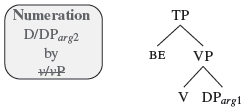
- b.
- Merging the By-phrase
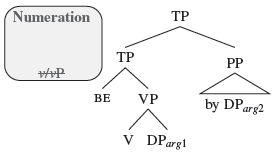
My proposal is to treat budded items as syntactically inert material. Re-use is only possible if the item is selected by another head, like the preposition by in (39b). What is not possible for budded items, however, is to re-enter the derivation as selecting heads. The reason is relatively simple. Once a head has satisfied its features, including selectional ones, it stops acting as a probe. This holds for any item inside an active derivation, and it should hold for items that have been removed from a derivation as well. This is enough to prevent the v(P) to remerge in the case of passive derivations, and is also enough to prevent remerge of any functional material that has been budded. Indeed, a selecting head should have all its features checked before the next selecting head enters the derivation. In other words, a head becomes syntactically inert before a new one enters the derivation. However, the fact that an item cannot act as a probe anymore does not prevent it from being a possible goal. This is what I claim happens in the case of by-phrases and could happen to any budded item. Again, there is nothing different in this respect from what already happens with normal derivations. Inert elements in a derivation participate in a probe-goal relation as goals both if they are heads (e.g., with head-movement in the verb-auxiliary domain) or phrases (e.g., DP movement). This extends to elements that have been budded as well. The general principles governing the re-use of budded material are summarized in (40).
- (40)
- Principles governing budded items
- a.
- Budded items don’t act as a probe because their probing features have already been checked.
- b.
- Budded items can re-enter the derivation if selected by another head.
3.2 Italian causative constructions as vP Bud
If the mechanics of passive includes Bud, then we should expect that any head budding down to a VP would generate a passive-like structure. A head with such properties would behave like the auxiliary be in removing the external argument along with the budded vP. The question is whether it is possible to identify such heads. The Italian causative construction seems to be a good candidate. Rizzi (1982: 28–29) noted that, differently from French (Kayne 1975), Italian causative constructions generate “a peculiar form of embedded passive, with postposing of the deep embedded subject in the agent phrase, but without insertion of the passive morphology”. The example in (41a) shows that the agentive phrase can be introduced either by the same preposition introducing the passive by-phrase “da” or by the preposition “a”. Interestingly, the English equivalent in (41b) does not show any property of passive constructions. Indeed, the subject of the embedded verb remains in preverbal position.
- (41)
- a.
- Mario
- Mario
- ha
- has
- fatto
- make
- portare
- bring
- quella
- that
- torta
- cake
- a/da
- by
- Piero.
- Piero
- b.
- Mario had Piero bring that cake.
A Bud derivation of Italian causatives easily accounts for the passive-like properties of the construction. Fare (lit. do in English) would act as a sort of light vP budding the already present vP projected by the lower predicate portare (bring), as in (42a). The external argument of fare is normally merged as in (42c), while the by-phrase allows the agent of the lower predicate to re-enter the derivation as in canonical passive derivations (not shown).
- (42)
- A Bud Derivation of Causative constructions
- a.
- vP Before BUD
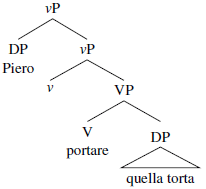
- b.
- Fare selects VP
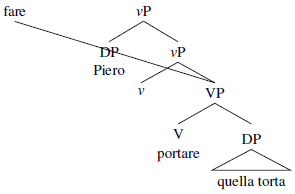
- c.
- After BUD
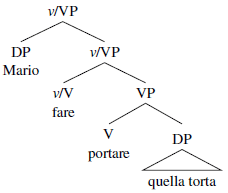
If a passive-like derivation with vP budding is available for Italian causative constructions, one might expect that the agent of the embedded predicate is able to bind a null pronoun inside an adjunct clause, like in the passive examples discussed in (37) above.28
For completeness, I report both cases in which the adjunct CP is finite and non-finite. When all participants to the event are overtly expressed in the appropriate scenario, a null pronoun can be bound by the matrix subject (43a–43b), the agent of the embedded predicate (44a–44b) or both (45a–45b). When the agent of the embedded predicate remains unexpressed, it is still possible to have co-reference with the null pronoun inside the adjunct clause (44c–44d), although the status of the example with the infinitival adjunct is slightly degraded. Finally, split co-reference is possible both with the infinitival and finite adjunct clause (45c–45d).
- (43)
- Scenario: Gianni is biking when he realizes he has a flat tire. He stops by Piero the mechanic and …
- a.
- Giannii
- Gianni
- fece
- made
- cambiare
- change
- la
- the
- ruota
- tire
- a
- to
- Pierok
- Piero
- per
- to
- PROi/*k
- PRO
- proseguire
- continue
- il
- the
- viaggio.
- journey
- ‘Gianni had Piero change the tire to continue the journey.’
- b.
- Giannii
- Gianni
- fece
- made
- cambiare
- change
- la
- the
- ruota
- tire
- a
- to
- Pierok
- Piero
- affinché
- so that
- proi/*k
- proseguisse
- continue
- il
- the
- viaggio.
- journey
- ‘Gianni had Piero change the tire so that he could continue the journey.’
- (44)
- Scenario: Piero is biking in a long distance race. At an intermediate Pit-Stop Gianni, his coach, realizes that there is something wrong with Piero’s rear tire. Piero didn’t want to loose time, but Gianni insisted. Since only racers can touch their bike during the competition …
- a.
- Giannii
- Gianni
- fece
- made
- cambiare
- change
- la
- the
- ruota
- tire
- a
- to
- Pierok
- Piero
- per
- to
- PRO*i/k
- PRO
- proseguire
- continue
- la
- the
- gara.
- race
- ‘Gianni had Piero change the tire to continue the race.’
- b.
- Giannii
- Gianni
- fece
- made
- cambiare
- change
- la
- the
- ruota
- tire
- a
- to
- Pierok
- Piero
- affinché
- so that
- pro*i/k
- proseguisse
- continue
- la
- the
- gara.
- race
- ‘Gianni had Piero change the tire so that he could continue the race.’
- c.
- Giannii
- Gianni
- fece
- made
- cambiare
- change
- la
- the
- ruota
- tire
- per
- to
- PRO*i/?k
- PRO
- proseguire
- continue
- la
- the
- gara.
- race
- ‘Gianni had Piero change the tube to continue the race.’
- d.
- Giannii
- Gianni
- fece
- made
- cambiare
- change
- la
- the
- tire
- tire
- affinché
- so that
- pro*i/k
- proseguisse
- continue
- la
- the
- gara.
- race
- ‘Gianni had Piero change the tire so that he could continue the race.’
- (45)
- Scenario: Gianni and Piero are biking together when Gianni realizes he has a flat tire. Since Piero is quite skilled …
- a.
- Giannii
- Gianni
- fece
- made
- cambiare
- change
- la
- the
- ruota
- tire
- a
- to
- Pierok
- Piero
- per
- to
- PROi+k
- PRO
- proseguire
- continue
- il
- the
- viaggio
- journey
- insiemei+k.
- together
- ‘Gianni had Piero change the tire to continue the journey together.’
- b.
- Giannii
- Gianni
- fece
- made
- cambiare
- change
- la
- the
- ruota
- tire
- a
- to
- Pierok
- Piero
- affinché
- so that
- proi+k
- proseguissero
- continue
- il
- the
- viaggio
- race
- insiemei+k.
- together
- ‘Gianni had Piero change the tire so that they could continue the journey together.’
- c.
- Giannii
- Gianni
- fece
- made
- cambiare
- change
- la
- the
- ruota
- tire
- per
- to
- PROi+k
- PRO
- proseguire
- continue
- il
- the
- viaggio
- journey
- insiemei+k.
- together
- ‘Gianni had Piero change the tire to continue the journey together.’
- d.
- Giannii
- Gianni
- fece
- made
- cambiare
- change
- la
- the
- ruota
- tire
- affinché
- so that
- proi+k
- proseguissero
- continue
- il
- the
- viaggio
- journey
- insiemei+k.
- together
- ‘Gianni had Piero change the tire so that they could continue the journey together.’
These examples, in particular (44c), replicate the pattern found with the passive construction (see the examples in 37).29
As a final point of similarity with passive constructions, the agent of each predicate can be left unexpressed, as shown in (46).30
- (46)
- a.
- La
- The
- torta
- cake
- fu
- was
- fatta
- made
- portare
- bring
- a
- to/by
- Piero
- Pietro
- sul
- on.the
- carrello.
- trolley
- ‘Someone had Piero carry the cake on the trolley.’
- b.
- La
- The
- torta
- cake
- fu
- was
- fatta
- made
- portare
- bring
- sul
- on.the
- carrello
- trolley
- da
- by
- Gianni.
- Gianni
- ‘Gianni had someone carry the cake on the trolley.’
- ‘Someone had Gianni carry the cake on the trolley.’
- c.
- La
- The
- torta
- cake
- fu
- was
- fatta
- made
- portare
- bring
- sul
- on.the
- carrello.
- trolley
- ‘Someone had someone (else) carry the cake on the trolley.’
Causative have shows completely different syntactic properties in English. These are compatible with have merging to the vP. Hence the external argument remains sandwiched between the two verbs. The unacceptable (47c), where the adverbial PP modifies the causative predicate, indicates that the embedded subject has not raised to the phrase headed by the causative marker.
- (47)
- a.
- Mary had Peter bring that cake.
- b.
- Mary had with all her heart Peter bring that cake.
- c.
- *Mary had Peter with all her heart bring that cake.
If causative have in English is a light verb that selects v-like elements then nothing should be added. Standard precedence of merge over move would block movement from spec,vP to spec,TP, so that the external argument of have can be merged from the numeration. In this perspective, the difference between Italian and English causatives is the selection specification of the causative predicate itself. Italian fare takes a VP complement, while English have takes a vP one.
4 Extending the proposal: Budding CP/TP
Pesetsky (2021) proposes a treatment of infinitival complements in terms of structure reduction caused by Exfoliation. Concretely, infinitival complements are generated from fully fledged CPs. In order to allow for the subject to move from the embedded complement into the matrix clause, a reduction of the CP/TP must be performed across phases. Removing the TP projection is one way languages have to free the embedded subject.31 The advantage of this approach is that all complement taking predicates would select for a CP and all sentential complements would be generated as fully fledged CPs.
In this section, I briefly explore how budding the CP/TP portion of a clause leads to similar results by discussing raising to object constructions. In doing this, I will heavily draw from Pesetsky’s (2021) work. The core idea is very simple: CP/TP budding generates infinitival constructions exactly in the same way as vP budding generates passive constructions. Once the projection governing tense is removed from the derivation, the remaining structure is spelled out as infinitival. As with the derivation of passive, I will keep the amount of structure at the very minimum. CP and TP are intended as umbrella categories where the projections identified by the cartographic approach to syntax are collapsed. The phrase marked as toP represents the projection targeted by Bud, exactly the same one proposed in Pesetsky (2021). The general schema is given in (48), where α indicates the matrix predicate, which can optionally select for either a CP or a toP:
- (48)
- Budding the CP/TP
- a.
- Before BUD
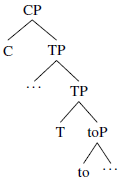
- b.
- Budding head
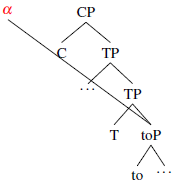
- c.
- After BUD

Pesetsky (2021) reviews several arguments showing that in Raising to Object constructions, the post-verbal nominal has some properties typical of the object of the higher clause, like accusative case, upper clause binding domain, c-commanding elements in the higher clause; and other properties typical of the subject of the embedded clause, like presence of expletive pronouns and availability of idiomatic readings. One possible explanation is that the nominal element starts the derivation as the subject of the embedded clause and raises to the specifier of the VP of the matrix clause (Johnson 1991; Lasnik & Saito 1991). The derivation of the example in (49a) is given in (49b).
- (49)
- a.
- Mary proved Sue conclusively to deserve the prize. =(6a, Pesetsky 2021: 5)
- b.
-
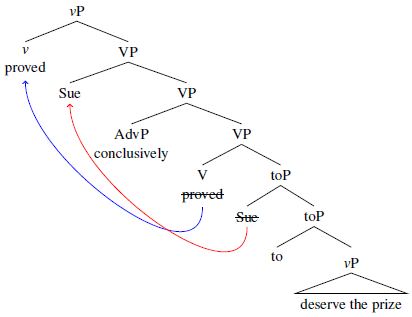 = (8, Pesetsky 2021: 6)
= (8, Pesetsky 2021: 6)
The question is how it is possible that the embedded sentence ends up with a reduced structure containing a toP rather than a CP. On the one hand, the problem is similar to that of passive, where we had to motivate the absence of the external argument, without looking ahead to the next steps of the derivation. On the other hand, the fact that the embedded sentence does not have a CP introduces additional complications in the alternation of vP and CP phases in sentence building. Specifically, the clausal complement is left without a phase head.32
A Bud approach to Raising to Object can account for the lack of the embedded CP (i.e., the missing phase head) and the fact that accusative case can be assigned to the subject of the embedded clause at once. Indeed, the embedded sentence does have its own CP before the raising verb enters the derivation, as in (50a). At this stage, the subject has moved to spec,TP like in fully fledged sentential complements.33 The raising predicate searches for a toP and scans its c-command domain for a goal to which it assigns accusative case, as in (50b).34 Finally, due to an epp feature, the goal is raised to spec,VP of the raising predicate, as in (50c).
- (50)
- Derivation of Raising to Object
- a.
- CP Before BUD
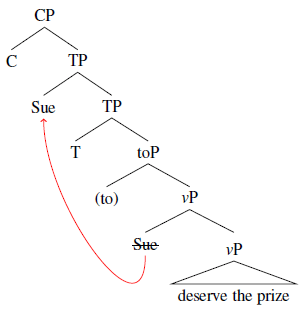
- b.
- V selects toP
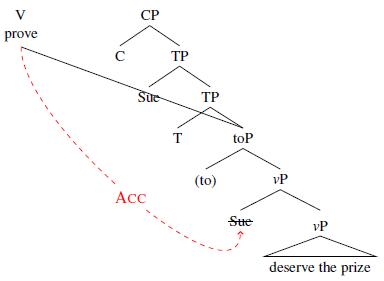
- c.
- V After BUD
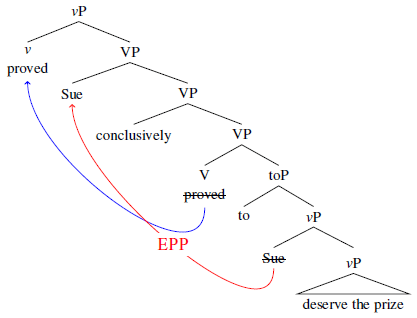
This is a case of movement of the lower copy after Bud described in Section 2.4.35 Bud removes the entire TP including the higher copy of the embedded subject. However, the new re-opened phase makes the specifier of vP available again. It is from that position that it raises to the specifier of the higher predicate. A Bud approach to raising differs from other accounts in that there is no need to assume short movement of the subject up to toP before structure removal.36 The subject in spec,TP cannot be a suitable goal because it is outside the search domain, hence the block operated by the criterial position is by-passed.
The account just sketched for raising to object constructions easily extends to the derivation of Raising to Subject sentences. The only differences are that raising to subject predicates do not assign accusative Case, and that the raised DP further moves from spec,VP of the main verb to the main spec,TP, where it receives again nominative Case.
One remark concerns the availability of expletive elements in raising constructions. Pesetsky (2021) reports the following two examples as cases where the raised element is an expletive pronoun.
- (51)
- a.
- Mary judged there to be a good reason for the meeting. = (4a Pesetsky 2021: 4)
- b.
- The detective proved it to have been raining when the murder was committed. = (4b Pesetsky 2021: 4)
In a Bud perspective, the following examples are perhaps more intriguing and reveal a surprising aspect of “obligatory” re-merge after structure reduction. The examples in (52) are cases of raising to subject and raising to object and both involve the expletive pronoun there. Expletive there is externally merged at the TP level or earlier at the vP level (Deal 2009), preventing movement from the embedded clause. This is done under the assumption that merge prevents move when the expletive is part of the numeration (Chomsky 2000).
- (52)
- a.
- There seems to be a man in the garden.
- b.
- I would not have believed there to be a man anywhere bold enough to make such a proposal […] (from Donaldson 2007: 214)
In the implementation offered here, reduction re-sizes the structure down to toP, then attraction to the matrix clause is performed via agree+EPP. Curiously, since I am not assuming any movement of the subject to spec,toP, this second cycle shows exactly the same situation as the first cycle, with a DP in the embedded vP/copular structure being selected as a goal, while the EPP feature of the probe is satisfied via external merge of the expletive. This results in the obligatory re-merge of the budded expletive, which is not motivated by Bud per se but by the fact that there is an available expletive in the workspace. Once applied to raising to subjects, the derivation in (51) correctly excludes intermediate derivations in which the DP internally moves to spec,TP and then the expletive is merged directly in the specifier of the raising predicate yielding the ungrammatical * there seems a man to be in the garden.
Before I conclude this section, it is worth mentioning that this formal approach to raising constructions does not answer the question of why raising predicates exist to begin with. Unfortunately, in lack of a principled explanation, I can only appeal to some lexical properties of these predicates. Although at a slightly different level, a similar question also concerns the alternation of infinitival and finite sentential arguments if Bud is used as a generalized operation to derive all types infinitival constructions, including control and restructuring. The selectional requirement that allows the alternation between finite and infinite complements must be stipulated in a Bud approach, while Exfoliation provides a concrete motivation, since infinitival structures exist to guarantee an otherwise illicit movement from the embedded clause. I hope to be able to provide a deeper explanation to these facts within the Bud system in future research.
5 Conclusions
Structure reduction is at the core of a consistent number of syntactic constructions like analytic passive, Italian causative, raising and more generally infinitival complements. The role of these constructions in the grammar is far from marginal, therefore the mechanisms underlying their derivation must be central as well. I offered Bud, a Merge-based operation, as the key ingredient performing structure reduction. The crucial property of Bud is that the head triggering the operation does not Merge to the root of a syntactic object but at a lower projection, hence removing the higher portion of a structure. Like Merge, Bud is constrained by Minimality and cyclicity. Its top-down implementation prevents from looking ahead to later stages of a derivation. In this work, I restricted the empirical domain to reductions affecting the backbone of the sentence (vP or CP/TP budding). However, nothing prevents Bud from applying to the syntax of nominal expressions, one potential candidate being reduced relative clauses. These and other constructions constitute the empirical domain and the testing ground of a promising area of research.
Supplementary file
The supplementary file containing the two appendices can be found at the following address: DOI: https://doi.org/10.16995/glossa.5759.s1
A Remove, Exfoliation and Bud
B Language, Cognitive resources and the Optimal design
Notes
- I am grateful to Jeremy Kuhn for proposing this name. [^]
- Labels are included in the formalism. In systems where c-selection emerges as a mechanism of feature valuation or feature sharing, δ is endowed of a feature that is specified in β but not in α. In other words, δ would act as a probe looking for its goal in β passing across α. [^]
- One notable exception of (Internal) Merge not targeting the root are cases where an XP is allowed to tuck in right below an already moved element as in some cases of multiple wh-questions (Richards 1999). [^]
- Exfoliation suffers from the same problem, while it is less clear whether Remove does too. [^]
- If alternative definitions of the Phase Impenetrability Condition are considered, like the one proposed in (Boskovic 2015: 617) where the maximal projection of the phase complement is also visible, the search space would be slightly different and the empirical differences with the effect of Minimality on Bud become hard to find since the two constraints would yield very similar results. The problem of budding lower phrases would still remain, though. [^]
- In a label free syntax, the minimal assumption is to allow for impoverished/stripped phrase markers, namely projections whose head is no more syntactically active, to be visible after spell-out. [^]
- One possible reflection of the presence of a within-phase budded head could be on the morphology of other lexical items in a situation described above in (12). [^]
- Allowing the numeration to host complex syntactic objects may be independently needed as a temporary store during sentence building. A complex DP or a PP can be temporarily stored in the numeration until it is merged to the main structure (see Zwart 2009; 2011; De Belder & Van Craenenbroeck 2015). [^]
- In the Exfoliation approach, specifiers are allowed to remerge automatically to the higher head. Strictly speaking this is not allowed in this system because merge is driven by selection or by probe-goal plus EPP. Notice that allowing specifiers to remerge to higher levels might be problematic for semantic reasons. Suppose one of the budded specifiers/adjuncts in (23) is an adverbial. Before Bud, the adverbial would have scope on the lower predicate, while in the remerged position it would modify the meaning of the higher predicate. These derivations are correctly blocked in the current system. [^]
- Of course, this issue is less relevant if the computational system has constant access to the lexicon. [^]
- For alternative derivations like (22) or (23c), re-merge would require another application of bud since ɣ is still part of another syntactic object. [^]
- Unless differently specified, judgments on the Italian data are my own and have been confirmed by five native speakers, who are all linguists. [^]
- If this operation were to be allowed, the result would be one single syntactic object corresponding to a transitive sentence with the exhausted be auxiliary back in the numeration. In this case, after C merges with the only TP left in the workspace, the derivation is not expected to crash at the interface, but it is expected to generate a simple transitive sentence. The consequence of this may not be ultimately negative. In such unconstrained applications of Bud, the lexical entry for auxiliaries would always contain active and passive features, leading either to a passive or an active sentence depending on higher level constrains like having an agent in the background or a more focalized object. [^]
- Another possible factor to add to this typology is whether the subject can control agreement morphology on the verb. Unfortunately, the data I have been able to recover from the literature are not conclusive. [^]
- Some of the languages reported in Table 3 have passive morphology but it is not clear whether they also have an overt passive auxiliary. I assume that sentence reduction is produced by a covert auxiliary for these languages. The passive morphology on the verb would be the result of the process. [^]
- Preliminary evidence that the subject is not in spec, vP at least in active sentences can be found for Nuer and Creek, as shown in the examples below. In the Neur example, the subject is found to the left of the auxiliary ci (Frank 1999), while in Creek the subject is optionally found before the time adverbial (again), as well as before manner adverbs and expressions of locations (Martin 2011: 376).
- i
- dhɔɔl
- boy.nom.pl
- diɔk
- three
- ci
- aux
- kɛ
- pl
- we
- go
- may. (Nuer, Frank 1999: 16, example 2)
- fish
- ‘Three boys went fishing.’
[^]- ii
- hatâm
- again
- hahá-t
- wolf-nom
- hatâm
- again
- a:ɬ-ít
- go.about.sg.asp-nom
- o:m-ín. (Creek, Martin 2011: 374, example 21)
- beasp-n
- ‘[As rabbit was going about,] again, wolf, too, was about …’
- The closest language documented would been Dholuo, which has been argued not to have EPP feature in these particular constructions (Cable 2012). Unfortunately, the language does not have overt case marking. [^]
- Abbreviations: def = definite, ds = different subject, imp = imperfective, lgr = lower pitch grade (a from of the stem), obl = oblique, pfv = perfective, pl = plural, prep = preposition, rel = relative marker, decl = declarative marker. [^]
- Ryu (2013) reports a number of other restrictions for this particular case pattern including the fact that the leftmost nominal must be animate and that this differentiated case marking is only found in lexical passive. It is likely that these extra constraints are regulated by additional semantic requirements and morpho-phonological processes. [^]
- Things could be slightly different if the workspace is already endowed with all elements of a numeration. [^]
- A Glossa reviewer pointed out that reduced relative clauses also involve a form of passivization, although they do not overtly contain the auxiliary be. This is captured by assuming that invisible functional heads may bud structures producing other forms of passive, see also impersonal passives in German in the example (33). [^]
- The use of possessive have may have been derived from a be possessive construction in Italian (Latin sum+dativum, Possessive Dative) and in other languages as well (Alexiadou 2001: 192). In simple tenses where no auxiliary is present, I assume a null version of the relevant functional head to be active. [^]
- Sensitivity to animate/human agents, telicity and geographical variation documented for impersonal passive as well as auxiliary selection in German intransitive predicates cannot be accounted exclusively by Bud, which simply acts as the trigger of a reduced structure. See Keller & Sorace (2003) for experimental evidence. [^]
- Gianni is biking when he realizes that he has a flat tire. In a few minutes, … [^]
- The scenarios that make the relevant reading accessible are given below:
- i.
- Scenario for (38b): Despite the fact that the school inspector brought clear evidence …
[^]- ii.
- Scenario for (38c): Once the evidence was clearly shown the discussion was over.
- The fact that the German examples are unacceptable simply means that German does not allow for this possibility. [^]
- A Glossa reviewer points out that in a budding derivation, the external argument receives the case normally assigned to subjects (i.e., nominative or ergative). Given the typology discussed in Table 3 above, this predicts that we could find languages in which this case is retained in the by-phrase. Unfortunately, I am not aware of languages showing this pattern. [^]
- I am grateful to a Glossa reviewer for having pointed out this point. [^]
- A curious fact that to my knowledge has never been reported in the literature regards the participants to the event in Italian causatives. The agent of the embedded predicate can be expressed either with the standard by-phrase or with a PP headed by the preposition ‘a’. Interestingly, when the main clause is also passivized, the agent of the embedded predicate must be expressed by the preposition ‘a’, while the preposition ‘by’ introduces the agent of the main clause.
- (1)
- a.
- Quella
- That
- torta
- cake
- fu
- was
- fatta
- made
- portare
- bring
- a
- to/by
- Piero
- Piero
- da
- by
- Mario.
- Mario
- ✔ Mario had Piero bring the cake.
- ✔ Mario had someone bring the cake to Piero.
- b.
- Quella
- That
- torta
- cake
- fu
- was
- fatta
- made
- portare
- bring
- da
- by
- Piero
- Piero
- a
- to
- Mario.
- Mario
- ?*Mario had Piero bring the cake. (with neutral intonation)
- ✔ Piero had someone bring the cake to Mario.
While word order restrictions claim for a syntactic account, possible semantic conflicts with respect to the attachment of the by-phrases make the derivation not completely transparent. I leave this issue open for future research. [^]- c.
- Quella
- That
- torta
- cake
- fu
- was
- fatta
- made
- portare
- bring
- da
- by
- Piero.
- Piero
- ✔ Someone had Piero bring the cake.
- ✔ Piero had someone bring the cake.
- I am grateful to a Glossa reviewer for having pointed out these cases. [^]
- An alternative strategy available in languages like in Italian is not to move the subject into spec,TP at all. [^]
- Pesetsky (2021) proposes that phasehood is inherited by toP, so the complement is not left without a phase head. [^]
- Bud shares with Exfoliation the fact that the sentential complement of Raising to Object constructions is a complete CP. My proposal is different from Pesetsky (2021) in that it does not assume short movement of the embedded subject to toP. [^]
- Notice that the embedded subject has already received nominative case before the TP is budded. [^]
- This particular interaction between Bud and movement makes interesting predictions if, as expected, minimality actively constraints the search from a matrix probe. Specifically, if a language allows short A’-scrambling above vP and Bud cuts the CP up to the landing site of the scrambled object then direct A’-movement of the subject from vP is blocked by minimality, while A-movement of the subject would be allowed. Similarly, short A-scrambling of the object past the subject would block subject A-movement but not subject A’-movement. These are interesting predictions to test, something I will leave for future research. [^]
- Alternatively, one can still assume that on its way to TP, the subject makes an intermediate stop in spec,toP and from this position it gets attracted to the main clause VP, as in Pesetsky (2021). This analysis captures in a very easy way the distribution of the quantifier all in West Ulster English by McCloskey (2000). [^]
Acknowledgements
I am immensely grateful to David Pesetsky for the intense discussions, comments and suggestions on several parts of the paper. I am grateful to Marco Angster, Carlo Cecchetto, Caterina Donati, Maria Teresa Guasti, and Andrea Sansò for their valuable comments as well as to all Glossa reviewers who really helped me to improve the paper. Special thanks are also due to the audience of GLOW 43 – Berlin.
Funding information
Part of this research received funding from the European Research Council (ERC) under the European Union’s Horizon 2020 research and innovation programme (grant agreement No 788077, Orisem, PI: Schlenker). Research was conducted at Institut d’Etudes Cognitives, École Normale Supérieure – PSL Research University. Institut d’Etudes Cognitives is supported by grants ANR-10-IDEX-0001-02 and FrontCog ANR-17-EURE-0017.
Competing interests
The author has no competing interests to declare.
References
Alexiadou, Artemis. 2001. Functional structure in nominals: Nominalization and ergativity. John Benjamins Publishing Company. DOI: http://doi.org/10.1075/la.42
Baker, Mark C. 1985. The mirror principle and morphosyntactic explanation. Linguistic Inquiry 16(3). 373–416. DOI: http://doi.org/10.2307/4178442
Baker, Mark C. & Johnson, Kyle & Roberts, Ian. 1989. Passive Argument Raised. Linguistc Inquiry 20. 219–251.
Baunaz, Lena & Haegeman, Liliane & De Clercq, Karen & Lander, Eric (eds.). 2018. Exploring nanosyntax. Oxford, UK: Oxford University Press. DOI: http://doi.org/10.1093/oso/9780190876746.001.0001
Bejar, Susana & Massam, Diane. 1999. Multiple Case Checking. Syntax 2(2). 65–79. DOI: http://doi.org/10.1111/1467-9612.00015
Boskovic, Zeljko. 2015. From the Complex NP Constraint to everything: On deep extractions across categories. Linguistic Review 32(4). 603–669. DOI: http://doi.org/10.1515/tlr-2015-0006
Cable, Seth. 2012. The optionality of movement and EPP in Dholuo. Natural Language & Linguistic Theory 30(3). 651–697. DOI: http://doi.org/10.1007/s11049-012-9172-6
Chomsky, Noam. 1957. Syntactic structures. Berlin: Mouton de Gruyter. DOI: http://doi.org/10.1515/9783112316009
Chomsky, Noam. 1988. Lectures on government and binding. Dordrecht, The Netherlands: Foris Publications.
Chomsky, Noam. 1995. The minimalist program. Cambridge, MA: MIT Press.
Chomsky, Noam. 2000. Minimalist Inquiries: The framework. In Martin, Roger & Michaels, David & Uriagereka, Juan (eds.), Step by step: Essays on minimalist syntax in honor of Howard Lasnik, chap. 3, 89–155. Cambridge, MA: MIT Press.
Chomsky, Noam. 2001. Derivation by phase. In Kenstowicz, Michael J. (ed.), Ken Hale: A life in language, chap. 1, 1–52. Cambridge, MA: MIT Press.
Chomsky, Noam. 2004. Beyond explanatory adequacy. In Belletti, Adriana (ed.), Structures and beyond, chap. 3, 104–131. Oxford University Press.
Chomsky, Noam. 2007. Approaching UG from Below. In Sauerland, Uli & Gärtner, Hans-Martin (eds.), Interfaces + recursion = language?, chap. 1, 1–29. Berlin, New York: Mouton de Gruyter. DOI: http://doi.org/10.1515/9783110207552-001. https://www.degruyter.com/view/books/9783110207552/9783110207552-001/9783110207552-001.xml
Chomsky, Noam. 2008. On phases. In Freidin, Robert & Otero, Carlos P. & Zubizarreta, María Luisa (eds.), Foundational issues in linguistic theory: Essays in honor of Jean-Roger Vergnaud, 1–34. MIT Press. DOI: http://doi.org/10.7551/mitpress/9780262062787.001.0001
Chomsky, Noam. 2009. Cartesian linguistics. Cambridge, UK: Cambridge University Press.
Chomsky, Noam. 2019. Some Puzzling Foundational Issues: The Reading Program. Catalan Journal of Linguistics Special Issue. 263–285. DOI: http://doi.org/10.5565/rev/catjl.287
Citko, Barbara. 2005. On the Nature of Merge: External Merge, Internal Merge, and Parallel Merge. Linguistic Inquiry 36(4). 475–496. http://www.mitpressjournals.org/doi/abs/10.1162/002438905774464331. DOI: http://doi.org/10.1162/002438905774464331
Collins, Chris. 2005. A smuggling approach to the passive in English. Syntax 8(2). 81–120. DOI: http://doi.org/10.1111/j.1467-9612.2005.00076.x
Danckaert, Lieven. 2017. The origins of the Romance analytic passive: Evidence from word order. In Mathieu, Eric & Truswell, Robert (eds.), Micro-change & macro-change in diachronic syntax, vol. 1, 183. Oxford University Press. http://www.oxfordscholarship.com/view/10.1093/oso/9780198747840.001.0001/oso-9780198747840-chapter-14. DOI: http://doi.org/10.1093/oso/9780198747840.003.0014
De Belder, Marijke & Van Craenenbroeck, Jeroen. 2015. How to merge a root. Linguistic Inquiry 46(4). 625–655. DOI: http://doi.org/10.1162/LING_a_00196
Deal, Amy Rose. 2009. The origin and content of expletives: Evidence from “selection”. Syntax 12(4). 285–323. DOI: http://doi.org/10.1111/j.1467-9612.2009.00127.x
Donaldson, Stephen. 2007. Mordant’s need. London, UK: Gollancz.
Embick, David & Noyer, Rolf. 2007. Distributed Morphology and the syntax/morphology interface. In Ramchand, Gillian Catriona & Reiss, Charles (eds.), The Oxford handbook of linguistic interfaces, chap. 9, 289–324. Oxford: Oxford University Press. DOI: http://doi.org/10.1093/oxfordhb/9780199247455.013.0010
Fitch, Tecumseh W. & Hauser, Marc D. & Chomsky, Noam. 2005. The evolution of the language faculty: clarifications and implications. Cognition 97(2). 179–210; discussion 211–25. http://www.ncbi.nlm.nih.gov/pubmed/16112662. DOI: http://doi.org/10.1016/j.cognition.2005.02.005
Fox, Danny & Pesetsky, David. 2005. Cyclic Linearization of Syntactic Structure. Theoretical Linguistics 31. 1–45. DOI: http://doi.org/10.1515/thli.2005.31.1-2.1
Frank, Wright Jay. 1999. Nuer noun morphology: University of New York at Buffalo MA thesis. https://doi.org/https://hdl.handle.net/11858/00-001M-0000-0012-7385-C
Gehrke, Berit & Grillo, Nino. 2009. How to become passive. In Grohmann, Kleanthes K. (ed.), Phase theory: Features, arguments, interpretations, Elsevier. DOI: http://doi.org/10.1515/9783110213966.231
Gerdts, Donna B. & Youn, Cheong. 1999. Case Stacking and Focus in Korean.pdf. In Kuno, Susumu (ed.), Harvard studies in Korean linguistics VI, 325–339. Seoul: Hanshin Publishing Company.
Givon, Talmy. 2001. Syntax 2. John Benjamins Publishing Company.
Halle, Morris & Marantz, Alec. 1993. Distributed morphology and the pieces of inflection. In Hale, Kenneth & Keyser, Samuel Jay (eds.), The View from Building 20, 111–176. Cambridge, MA: MIT Press.
Haspelmath, Martin. 1990. The grammaticization of passive morphology. Studies in Language 14(1). 25–72. DOI: http://doi.org/10.1075/sl.14.1.03has
Hauser, Marc D. & Chomsky, Noam & Fitch, Tecumseh W. 2002. The faculty of language: what is it, who has it, and how did it evolve? Science (New York, N.Y.) 298(5598). 1569–79. http://www.ncbi.nlm.nih.gov/pubmed/12446899. DOI: http://doi.org/10.1126/science.298.5598.1569
Johnson, Kyle. 1991. Object Positions. Natural Language & Linguistic Theory 9(4). 577–636. DOI: http://doi.org/10.1007/BF00134751
Kaufmann, Ingrid. 1995. O – and D-Predicates : A Semantic Approach to the Unaccusative-Unergative Distinction. Journal of Semantics 12(4). 377–427. DOI: http://doi.org/10.1093/jos/12.4.377
Kayne, Richard S. 1975. French syntax. MIT Press.
Keller, Frank & Sorace, Antonella. 2003. Gradient auxiliary selection and impersonal passivization in German: An experimental investigation. Journal of Linguistics 39(1). 57–108. DOI: http://doi.org/10.1017/S0022226702001676
Lasnik, Howard & Saito, Mamoru. 1991. On the subject of infinitives. In Dobrin, Lise M. & Nichols, Lynn & Rodriguez, Rosa M. (eds.), Papers from the 27th regional meeting of the Chicago Linguistic Society, 324–343. Chicago, IL: CSLI publications.
Maling, Joan & Kim, Soowon. 1992. Case assignment in the Inalienable Possession Construction in Korean. Journal of East Asian Linguistics 1(1). 37–68. DOI: http://doi.org/10.1007/BF00129573
Manzini, M. Rita. 2017. Passive, smuggling and the by-phrase. In LaCara, Nicholas & Moulton, Keir & Tessier, Anne-Michelle (eds.), A schrift to fest Kyle Johnson, 233–244. Amherst: University of Massachusets.
Martin, Jack B. 2011. A Grammar of Creek (Muskogee). University of Nebraska Press. DOI: http://doi.org/10.2307/j.ctt1df4h3s
McCloskey, James. 2000. Quantifier float and wh-movement in an Irish English. Linguistic Inquiry 31(1). 57–84. DOI: http://doi.org/10.1162/002438900554299
McFadden, Thomas & Alexiadou, Artemis. 2006. Auxiliary selection and counterfactuality in the history of English and Germanic. In Hartmann, Jutta M. & Molnárfi, Lásló (eds.), Comparative studies in Germanic syntax: From Afrikaans to Zurich German, 237–262. John Benjamins Publishing Company. DOI: http://doi.org/10.1075/la.97.12mcf
Müller, Gereon. 2017a. Structure removal: An argument for feature-driven Merge. Glossa 2(1). 1–35. DOI: http://doi.org/10.5334/gjgl.193
Müller, Gereon. 2017b. Structure removal in complex prefields. Natural Language & Linguistic Theory 36. 219–264. DOI: http://doi.org/10.1007/s11049-017-9374-z
Pesetsky, David. 2021. Exfoliation: Towards a derivational theory of clause size. Manuscript available at LingBuzz.net.
Richards, Norvin. 1999. Featural Cyclicity and the Operating of Multiple Specifiers. In Epstein, Samuel David & Hornstein, Norbert (eds.), Working minimalism, 127–158. Cambridge, MA: MIT Press.
Rizzi, Luigi. 1982. Issues in Italian syntax. Dordrecht, The Netherlands: Foris Publications. DOI: http://doi.org/10.1515/9783110883718
Rizzi, Luigi. 1990. Relativized minimality. Cambridge, MA: MIT Press.
Ryu, Byong-Rae. 2013. Multiple Case Marking Constructions in Korean Revisited. Korean Society for Language and Information 17(2). 1–27. DOI: http://doi.org/10.29403/LI.17.2.1
Siewierska, Anna. 2010. From third plural to passive: Incipient, emergent and established passives. Diachronica 27(1). 73–109. DOI: http://doi.org/10.1075/dia.27.1.03sie
van Riemsdijk, Henk. 2000. Free Relatives Inside Out. In PASE Papers in language studies, 223–233. Humanities GM/CLS.
Yoon, James Hye Suk. 2004. Non-nominative (major) subjects and case stacking in Korean. In Bhaskararao, Peri & Subbarao, Karumuri Venkata (eds.), Non-nominative subjects: Volume 2, 265–314. John Benjamins Publishing Company. DOI: http://doi.org/10.1075/tsl.61.15yoo
Zwart, Jan-Wouter. 2009. Prospects for Top-Down Derivation. Catalan Journal of Linguistics 8. 161–187. DOI: http://doi.org/10.5565/rev/catjl.146
Zwart, Jan-Wouter. 2011. Structure and Order: Asymmetric Merge. In Boeckx, Cedric (ed.), The Oxford handbook of linguistic minimalism, 98–118. Oxford University Press. DOI: http://doi.org/10.1093/oxfordhb/9780199549368.013.0005

